Introduction
Evening gowns are truly the most beautiful creations that the fashion world can think of. These evening gowns are not just items of clothing but are a symbol of beauty and creativity. These enchanting, beautiful dresses have carved for themselves a special niche in the hearts of fashion lovers across the world. Because these evening gowns have stood the test of time and as they have transcended trends and fashion rules, they are rightfully called the crown jewel of the fashion industry. This blog will delve in the many ways these evening gowns have evolved over centuries and how they remain the ideal garment choice for some of the most important moments in our lives.
The allure of the evening gowns lies in the way they enhance the beauty of the women who wear it. The way they elevate a simple moment of fashion into a timeless symbol of elegance is truly magical. Making some of the most beautiful gowns is no easy task, because these evening gowns have to be crafted with precision often including intricate details like hand embroidery work, exquisite fabric manipulation and craftsmanship. The appeal of evening gowns lie in the fact that often exotic and expensive materials are used in their creation, making them exude opulence in every way.
The elegance that is associated with the evening gowns moves beyond simple aesthetic appeal and goes into reflection of refinement and sophistication. To understand this better take the example of the classic and iconic black evening gown. Hollywood legends like Audrey Hepburn, Catherine Hepburn and many more such names have adorned the classic black evening gown and have made it an iconic part of fashion history. Today, it is often considered as a symbol of understated glamour.
To further emphasize the charm exuded by simple evening gowns, let us remember the iconic moment when Princess Diana wore the famous blue velvet gown designed by fashion designer Victor Edelstein and danced with actor John Travolta. This moment of beauty and grace captured the attention of the world and made Dian’s regal presence a topic to discuss everywhere. Not just this, but for the modern times this was the moment when modern evening gowns gained attention of the royalties all over the world.
Evening gowns may have had their inception in European roots but today because they have such global aesthetic appeal, their global variations have become cultural symbols in their own rights. For instance, the Indian designers have embraced this iconic silhouette and have made it their own by infusing traditional Indian elements into it. Bollywood sirens don these exquisitely made evening gowns on the silver screen and this fusion of cultures has resonated well with audiences all over the world.
Let us now delve deeper into the history of inception and then evolution of these gorgeous evening gowns. As this blog will take you on a fascinating journey of intricate creation of stories and memories, stay tuned for a tale of beauty and grace. generations and borders.
Origins of the Evening Gowns
Tracing the origins of evening gowns is difficult albeit a fruitful task. As we look through the annals of time, what we come across is a fascinating story of evolution that is placed in time periods and cultures spread all over the world. It all begins in the courts of medieval Europe, where the official clothing for women for festivities and royal gatherings were the evening gowns. These elaborately designed garments reflected the social stature of its wearer. The more exquisite the gown, the higher the social status. The now iconic shape of the evening gowns that is associated with formal functions was given to us by the Renaissance period, with higher emphasis on the voluminous skirts and more fitted bodices, distinguisheing it from the simplicity of everyday attire.
A pivotal role in reshaping the design of the evening gowns was played by the 17th century French court under Louis XIV. Aristocratic women were seen adorning themselves in sumptuous fabrics which often featured intricate and exotic embroideries. As mentioned before the exquisiteness of each gown reflected upon the social standing of its owner. These garments also reflected the importance and degrees of formality demanded by social and royal events and soirées. With time a standard was established where the purpose of the evening gowns became to exhibit the wealth and social success of its wearer, making them a symbol of prestige.
As we progressed towards the Victorian era, a shift was noticed in the design elements of evening gowns. The invention of the ‘hoop skirt’ in the mid-19th century helped in creating a distinct silhouette for the evening gowns. Now they featured voluminous skirts that often helped in accentuating the wearer’s hourglass figure. Boasting high necklines and long sleeves, these evening gowns took a stark departure from the more revealing attire of daily use.
A revolution was witnessed in evening gowns in the 20th century that reflected the changing times. The Roaring twenties, which embraced a more liberated style with the flapper dress, saw a drop in the waistline and a rise in the hemlines. The glamour quotient was raised when Hollywood actress of the 1930s and 1940s brought forth a sleeker and more sophisticated version of the evening gowns. Stars like Greta Garbo and Jean Harlow were often seen in these iconic designs, adding to their popularity.
Renaissance and Baroque Influences
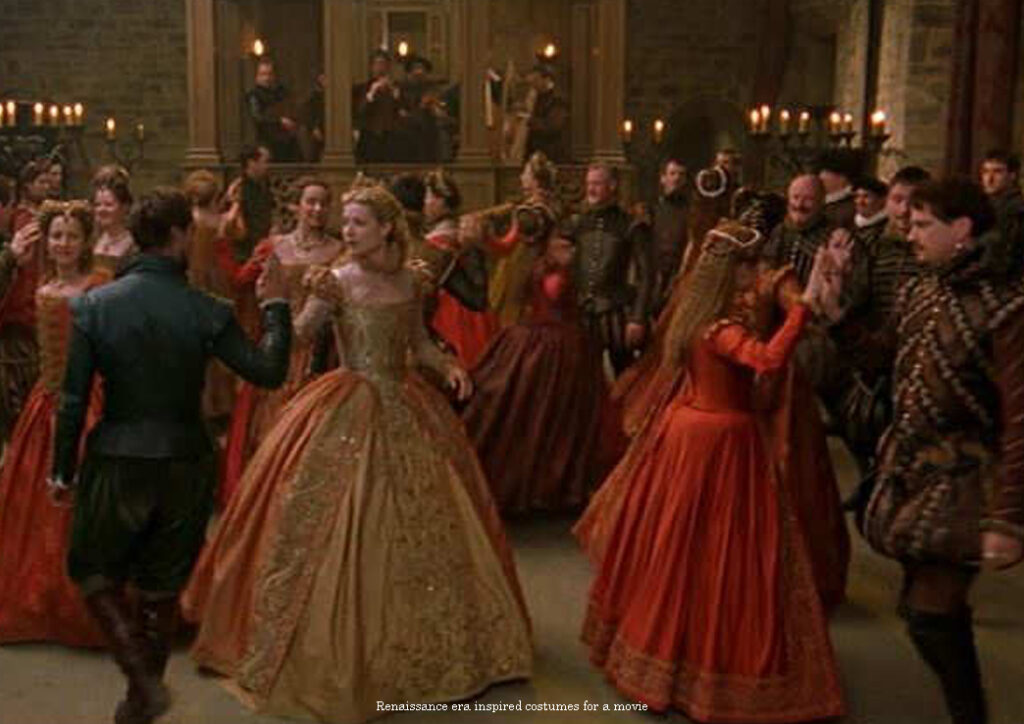
Both the Renaissance and Baroque eras were characterised by opulent grandeur and cultural shifts, which made lasting impacts on the evolutionary journey of the evening gowns. The Renaissance (14th to 17th centuries) were a time period in history when the world and Europe in specific witnessed a revival in art, literature and fashion. The impact on design sensibilities, fabrics, and silhouettes of evening gowns during this revival was culturally and profound.
While the medieval ages were marked with simplicity, the Renaissance brought a departure and the focus was more on forms and exaggerated aesthetics. The fashion of this era was highly under the influence of the courts of Italy, France and Spain. Expensive and lunch fabrics such as silks, velvets and brocades were adorned with intricate lace and embroideries. Continuing with the previous time periods, the richness of textiles and adornment reflected the economic prosperity of the prevalent times.
Moving to the Baroque era (17th to early 18th centuries), the evolution of the evening gowns continued where it was propelled into more exuberant and theatrical aesthetics. The silhouettes became more dramatic with wider skirts and puffed sleeves. The demand by aristocrats for luxurious textiles lead to import of exotic silks and brocades from the East. The grandiosity of Baroque architecture and art was also a major factor in the change in the fashion of the times, where these garments were but an elaborate expression of wealth and power.
As noticed, the socio-cultural shifts have always played a deciding role in shaping the design and future course of the evolution of evening gowns. While the Renaissance, which saw the rise of demand for exclusivity from the burgeoning merchant class. The Baroque era, which influenced the convergence of fashion with power, witnessed that clothing was used to assert social and political dominance. Thus, evening gowns became a means of visually telling of social hierarchy.
Victorian Era Elegance
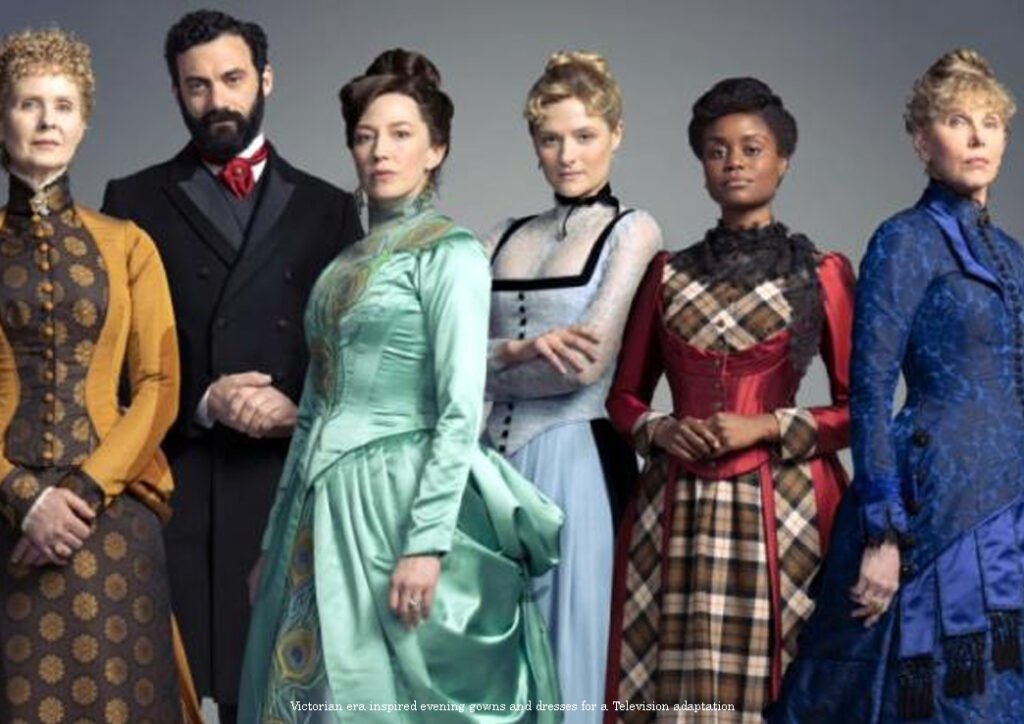
As we move forward towards the Victorian era (early 19th century to the early 20th century), the story of evolution of evening gowns took a different turn and moved into a new era of restrained elegance and intricate detailing. Named after Queen Victoria of England, the court of this British royalty guided the fashion sensibilities which saw emergence of a very distinctive characteristics.
This age was marked with sumptuous materials like satin, velvets, silks and taffeta. Departing from the softer colours, the use of rich, dark colours, including deep purples, burgundies and blacks defined this era. Victorian elegance was reflected in the social emphasis on modesty and formality. The fabrics and colours all came together to form a distinct narrative of life and aesthetics.
Victorian evening gowns bore the hallmark of highly intricate detailing, which exemplified the unparalleled craftsmanship of the time. Femininity and sophistication were redefined with elaborate lacework, delicate pearl and gold embroideries and exotics beading adorned bodices and sleeves. The starkly high collars and demure décolletages emphasized the Victorian ideals of modesty and decorum. The gowns were made even more alluring with often long and fitted sleeves that showcased intricate patterns of lace and beadwork.
What set the evening gowns of the Victorian era apart from the bygone times was the introduction of the crinolines and bustles. Invented in the mid-19th century, crinolines were stiff underskirts, usually made if horsehair or steel hoops, to create a bell like shape that will accentuate the waist. This was typical keeping in line with Victorian fascination with elaborate shapes and forms.
Roaring Twenties and Flapper Fashion
A seismic shift was observed in the aesthetics of the evening gowns style when the world collectively experienced the Roaring twenties, an era of exuberance, liberation, and iconic fashion. The transformation witnessed by society was fuelled by the socio-cultural changes which saw a marked departure from the structured elegance (often bordering on rigidity) of previous centuries.
As the flapper culture gained momentum, its influence was increasingly visible on the evening gowns style as well. Because the flapper was a symbol od the rebellious spirit of the 1920s, the evening gowns of this era embraced that idea with loose, drop-waist silhouette that allowed for unrestricted movement. Also, the effects of the Jazz Age and the Art-Deco movement were clearly visible in the straight, unadorned lines of the flapper silhouette.
A notable departure in the silhouette of the evening gowns was the visible shorter helms. It was a significant shift in ideology where high-rising hemlines exposed the knees. This change was a genuine reflection of the changing attitude of the society at large towards femininity and the standards it adhered to. As more women embraced this new freedom, the evening gowns of the Roaring Twenties became more and more iconic.
While the Victorian-era was defined by corsetry and constriction of the human body to achieve the beauty standards of a perfect hour-glass figure, the flapper age freed the waist in favour of a more natural straighter figure. This was not just a rebellion of fashion but the ideology of rigidity that was defining the beauty standards for women across the globe.
Fashion designer Coco Chanel played a crucial role in popularising the evening gowns of the 1920s. Her designs embraced the simplicity and functionality accompanied with a certain boyish charm that completely resonated with the flapper aesthetics. The glamour and the exuberance of this lavish jazz age was captured brilliantly in the fringe embellishments on evening gowns by fashion designers like Jeanne Lanvin and Madeleine Vionnet.
Mid-20th Century to Present
The ever-changing landscape of evening gowns and fashion is a very dynamic process to witness. And this was most evident during the mid-20th century when there was upheaval in the world and the world of fashion was a part of that. The post-war era saw the emergence of such styles and trends that continues to shape the face of evening gowns even today.
The most effective of these changes were brought about by a French designer named Christian Dior, who with his debut collection gave to the world ‘The New Look’. A full skirt with cinched waist and return to ultra feminine silhouette were the characteristics of a Dior woman. The post war optimism was reflected in the ample usage of luxurious fabrics to create some of the most lavish and memorable evening gowns the world has ever seen. The now iconic ‘Bar suit’ were all the rage but the real craze was after the Dior’ian evening gowns.
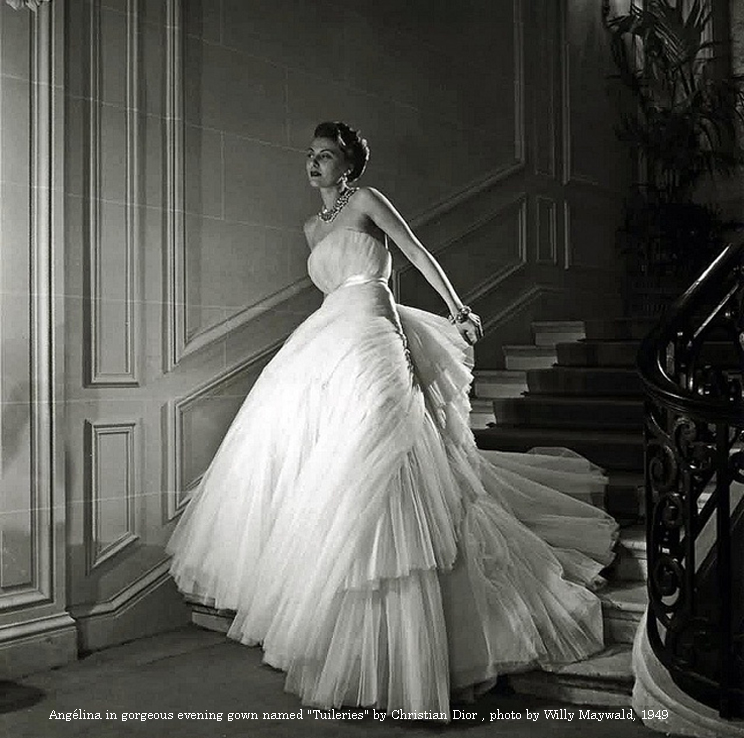
From the opulant feminine silhouettes, the 1960s marked a departure from the traditional long evening gowns. With the emergence of youth-driven culture led by fashion designers like Mary Quant and André Courrèges, the inventors mini and midi lengths, the notion of beauty was yet again challenged. Simultaneosuly this era of fashion saw the introduction of bold patterns and also unconventional choices for fabrics resonating the true spirit of the Swinging Sixties.
As the trend of counter-culture movemts gained momentum, the 1970s were a time to embrace individualism and self-expression. Fasion designers like Yves Saint Laurent and Halston introduced the world to a new range of evening goens options. From bohimian chic to minimalist geometric patterns, there was something new for everyone. This was also the Disco era and so the evening goens had that extra shimmer to them.
Continuing the trajectory of creating more and more extravagant gowns, the 1980s was time for fashion designers like Versace and Christian Lacroix. The power shoulders of the 80s and setailing which was larger than life , all were hallmarks of a true 1980s evening gown.
With the change of times, the 21st century saw return to sophistication and heightined feminity, but this time accompanied with diversity and inclusivity. Designers like Elie Saab and Marchesa brought international flavours to offer a broader spectrum of taste. A major cultural shift was towards inclusivity of body types and that led to designers like Christian Siriano creating more body inclusive evening gowns. All this happened and with the advent of technology and social media, the hype surrounding celebrity evening gowns amplified many times over.
Hollywood Glamour

Throughout the 20th century, Hollywood has played a decisive role in the evolution of evening gowns style. As the Golden Age of Hollywood spanned from the 1920s to 1960s, so did the evening gowns enjoy moments of pure beauty as unapparelled in any other time period. The allure of Hollywood glamour and the celebrities
The allure of Hollywood glamour has played a pivotal role in shaping the popularity and evolution of evening gowns, making them synonymous with sophistication and red-carpet elegance. The Golden Age of Hollywood, spanning the 1920s to the 1960s, was marked by iconic moments and celebrities whose sartorial choices contributed to the mystique surrounding evening gowns.
The Hollywood Red Carpet has played a crucial role when we discuss the impact of evening gowns on the general public. The Oscars’ red carpet in particular has become a coveted event in its own right. It is a showcase of breathtaking gowns made by the biggest fashion designers in the world. These gowns are worn by leading ladies which is where the global fascination with celebrity fashion begins. These gowns and events set standards for the future fashion cycles.
When talking of Hollywood and evening gowns, many names come to mind but none so strongly as Audrey Hepburn and the Hubert de Givenchy The Givenchy gown worn by Hepburn at the 1954 Academy Awards stands apart for many reasons, like the understated sophistication of her choice, but most of all it set the standards of Red Carpet glamour. On the same counts, Marilyn Monroe’s iconic silver screen moment where she stands on the subway grate in a pleated white halter gown will always remain in our collective memories.
The hold of Hollywood’s glamourous appeal will continue through out the 1960s with the rise of golden sirens like Elizabeth Taylor, Brigitte Bardot and Catherine Deneuve. Their overly opulent evening gowns featured some of the most intricate and extravagant embellishments of the time, capturing the essence of the decade. The ever so memorable red-carpet moment of the decade was when Grace Kelly wore a frosted evening gown designed by Edith head in 1955 and received the Academy Award for Best Actress.
Thus, the Golden Age of Hollywood was a pillar when discussing the elevation of evening gowns. This is how the legacy and power of Red-Carpet evening gowns was established. The impact that these celebrity worn gowns have over the global fashion can be visibly seen at all levels. These moments of sophistication and grace continue to weave a global fashion narrative.
Contemporary Trends and Innovations
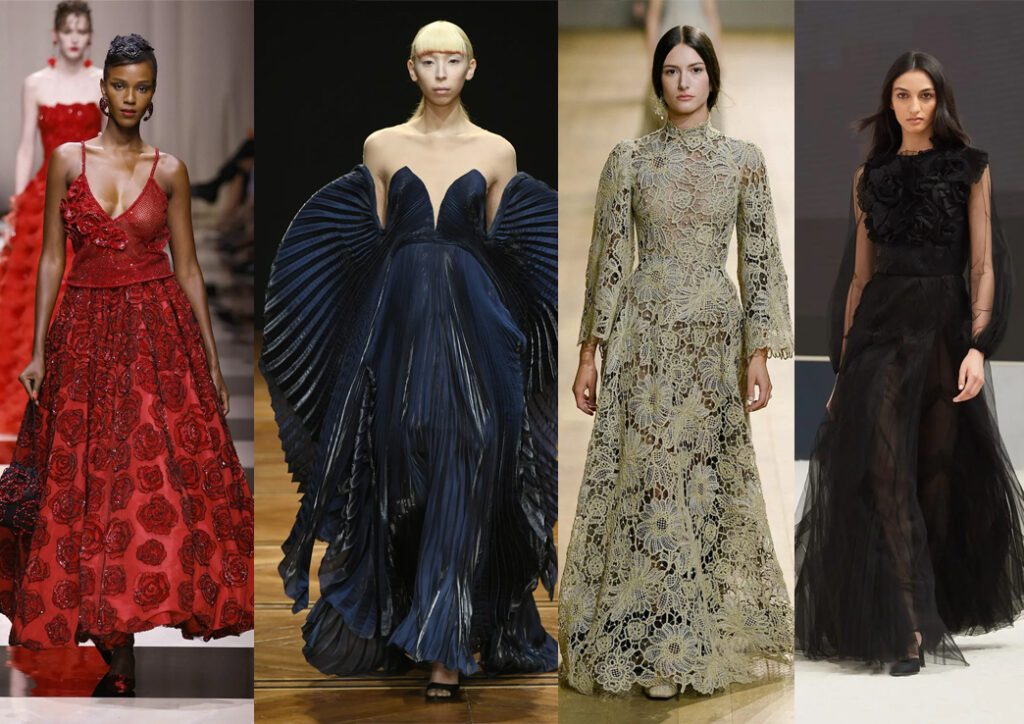
Evening gown designs from the latest runways of Armani, Iris Van Herpen, Dior and Chanel
Fashion is fuelled by constant innovation. And the realm of evening gowns is no exception, with modern designers relentlessly pursuing contemporary trends in technological advancements to push the boundaries of fashion. These torch bearers of modernisation in design, constantly experiment, use unconventional fabrics, and keep on redefining classic evening gown silhouettes to expand the already diverse range of evening gowns.
One main focus today is on sustainability. Keeping the demands of the informed and conscientious customer base, the fashion designers are increasingly incorporating eco-friendly fabric options in their design lexicon. Fabrics like organic cotton, recycled polyester, and sustainable versions of traditional fabrics like silk are being favoured by the modern client. One such luminary is designer Stella McCartney, who is a champion on sustainable fashion. Her designs prove that adopting ethical practices in now way hampers the elegance and beauty of an evening gown, thus aligning the eco-conscious values with glamour.
Another trend that has made its way in the evening gown segment is the resurgence of vintage-inspired designs. Bygone eras of fashion serve as powerful inspirations with new designers constantly referring to archival designs by fashion stalwarts like Chanel, Dior, Schiaparelli and many more. Alessandro Michele, whose work for the fashion brand Gucci is a perfect example where he inventively blends the old-world charm with modern sensibilities. He often incorporates vintage-inspired details such as embroideries from past collections and silhouettes into his evening gowns. Similarly, Givenchy’s Clare Waight Keller, constantly explores and redefines the classic column gown.
When we talk of modernisation of evening gowns, we have to talk separately of unconventional materials. Taking advantage of technology to its full extent is nowhere more evident as in the creations of designers like Iris Van Herpen, where she utilizes the wonders of 3D printing technology and innovative materials to create avant-garde gowns. These evening gowns are indeed wearable works of art.
Conclusion
In tracing the captivating journey of evening gowns through different eras and cultural shifts, a rich tapestry of evolution emerges, reflecting the ever-changing landscape of fashion. From the opulence of the Renaissance and Baroque periods to the structured elegance of the Victorian era, each era left an indelible mark on the design, fabrics, and silhouettes of evening gowns. The Roaring Twenties introduced a sense of liberation with flapper fashion, while Hollywood glamour in the mid-20th century elevated evening gowns to iconic status. The subsequent decades witnessed a dynamic interplay of diverse influences, from the innovative designs of contemporary fashion icons to a renewed emphasis on sustainability and inclusivity.
The key points in the evolution of evening gowns underscore the adaptability of these garments. Each era brought its own set of influences, responding to societal changes, technological advancements, and shifting cultural attitudes. The Renaissance and Baroque eras were marked by ornate details and grandeur, while the Roaring Twenties embraced a carefree spirit with shorter hemlines. Hollywood’s golden age infused glamour into every stitch, and the mid-20th century saw experimentation with styles and materials. Contemporary trends reflect a commitment to sustainability, inclusivity, and artistic innovation.
Through this journey, evening gowns have proven to be more than garments; they are cultural artifacts, embodying the ideals and aesthetics of their time. The enduring appeal of evening gowns lies in their ability to adapt and transform, continually captivating the imagination of fashion enthusiasts. Whether adorned by royalty, Hollywood stars, or individuals on a red carpet, evening gowns remain a symbol of grace, sophistication, and personal expression.
As fashion continues to evolve, evening gowns persist as timeless canvases where tradition and modernity meet. The legacy of evening gowns is a testament to their ability to transcend temporal boundaries, offering a glimpse into the ever-changing, yet enduring, world of fashion. In their evolution, evening gowns have not merely followed trends but have, time and again, set the stage for the next chapter in the captivating story of style.


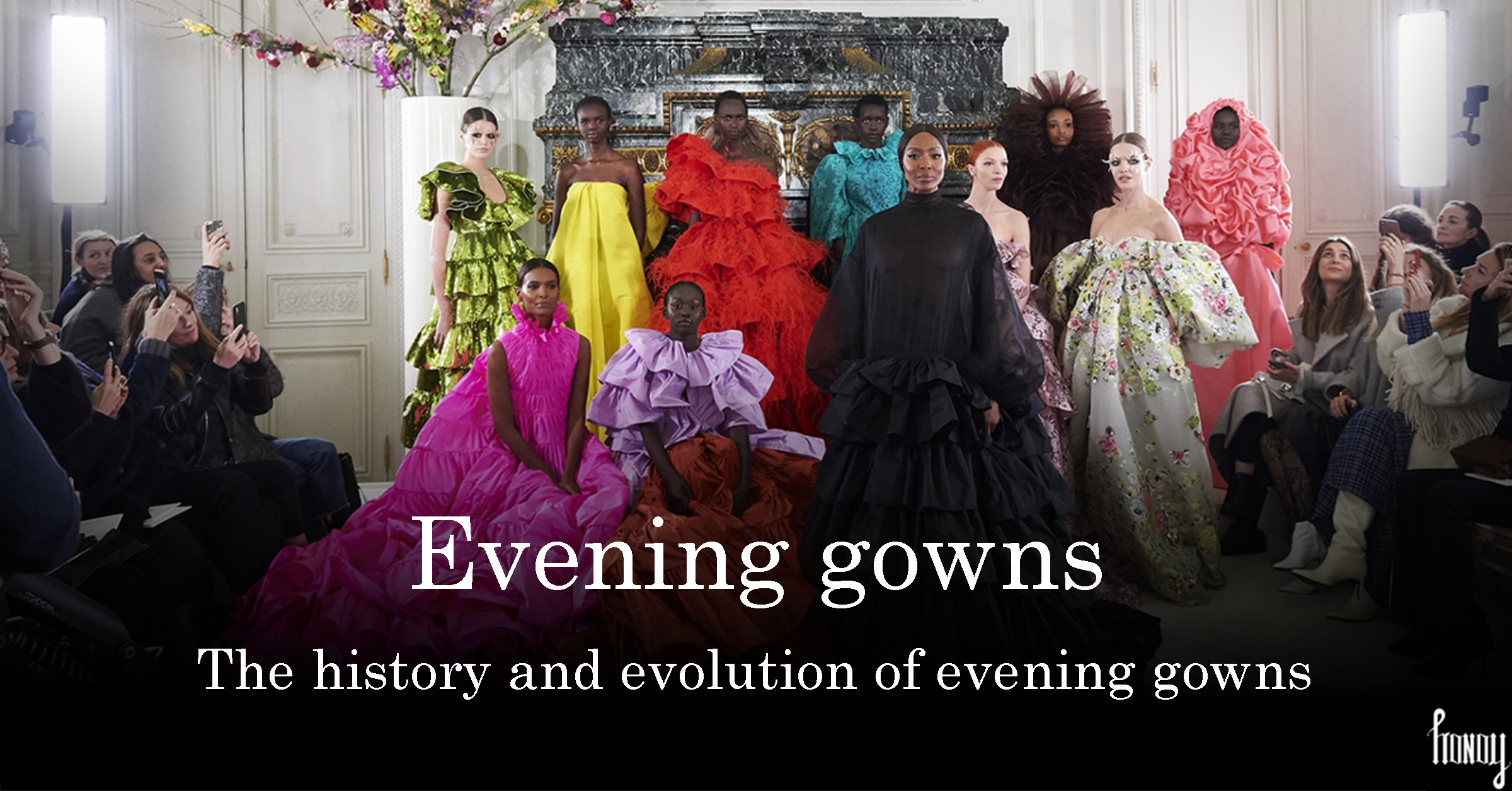


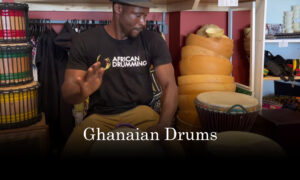



Pingback: Prominent Fashion & Social Movements - 19th And 20th Century
Pingback: 2 Ralph Lauren : Best American Fashion Designer Series